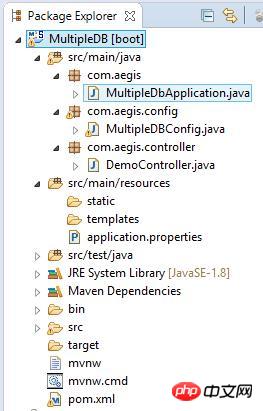Java Spring中同時存取多種不同資料庫的程式碼實例分享
開發企業應用程式時我們常常遇到要同時存取多種不同資料庫的問題,有時是必須把資料歸檔到某種資料倉儲中,有時是要把資料變更推送到第三方資料庫。使用Spring框架時,使用單一資料庫是非常容易的,但如果要同時存取多個資料庫的話事件就變得複雜多了。
本文以在Spring框架下開發一個SpringMVC程式為例,示範了一種同時存取多種資料庫的方法,而且盡量簡化配置變更。
建立資料庫
建議你也同時搭好兩個資料庫來跟進我們的範例。本文中我們用了PostgreSQL和MySQL。
下面的腳本內容是在兩個資料庫中建立表格和插入資料的命令。
PostgreSQL
CREATE TABLE usermaster ( id integer, name character varying, emailid character varying, phoneno character varying(10), location character varying ) INSERT INTO usermaster(id, name, emailid, phoneno, location) VALUES (1, 'name_postgres', 'email@email.com', '1234567890', 'IN');
MySQL
CREATE TABLE `usermaster` ( `id` int(11) NOT NULL, `name` varchar(255) DEFAULT NULL, `emailid` varchar(20) DEFAULT NULL, `phoneno` varchar(20) DEFAULT NULL, `location` varchar(20) DEFAULT NULL, PRIMARY KEY (`id`) ) INSERT INTO `kode12`.`usermaster` (`id`, `name`, `emailid`, `phoneno`, `location`) VALUES ('1', 'name_mysql', 'test@tset.com', '9876543210', 'IN');
建構專案
我們用Spring Tool Suite (STS)來建立這個範例:
點選File -> New -> Spring Starter Project。
在對話方塊中輸入專案名稱、Maven座標、描述和套件資訊等,點選Next。
在boot dependency中選擇Web,點選Next。
點選Finish。 STS會自動依照專案依賴關係從Spring倉庫下載所需的內容。
創建完的項目如下圖所示:

#接下來我們仔細研究專案中的各個相關文件內容。
pom.xml
pom中包含了所有需要的依賴和外掛程式映射關係。
程式碼:
<?xml version="1.0" encoding="UTF-8"?>
<project xmlns="http://maven.apache.org/POM/4.0.0"
xmlns:xsi="http://www.w3.org/2001/XMLSchema-instance"
xsi:schemaLocation="http://maven.apache.org/POM/4.0.0
http://maven.apache.org/xsd/maven-4.0.0.xsd">
<modelVersion>4.0.0</modelVersion>
<groupId>com.aegis</groupId>
<artifactId>MultipleDBConnect</artifactId>
<version>0.0.1-SNAPSHOT</version>
<packaging>jar</packaging>
<name>MultipleDB</name>
<description>MultipleDB with Spring Boot</description>
<parent>
<groupId>org.springframework.boot</groupId>
<artifactId>spring-boot-starter-parent</artifactId>
<version>1.3.5.RELEASE</version>
<relativePath />
</parent>
<properties>
<project.build.sourceEncoding>UTF-8</project.build.sourceEncoding>
<java.version>1.8</java.version>
</properties>
<dependencies>
<dependency>
<groupId>org.springframework.boot</groupId>
<artifactId>spring-boot-starter-web</artifactId>
</dependency>
<dependency>
<groupId>org.springframework.boot</groupId>
<artifactId>spring-boot-starter-test</artifactId>
<scope>test</scope>
</dependency>
<dependency>
<groupId>org.springframework.boot</groupId>
<artifactId>spring-boot-starter-jdbc</artifactId>
</dependency>
<dependency>
<groupId>org.postgresql</groupId>
<artifactId>postgresql</artifactId>
</dependency>
<dependency>
<groupId>mysql</groupId>
<artifactId>mysql-connector-java</artifactId>
<version>5.1.38</version>
</dependency>
</dependencies>
<build>
<plugins>
<plugin>
<groupId>org.springframework.boot</groupId>
<artifactId>spring-boot-maven-plugin</artifactId>
</plugin>
</plugins>
</build>
</project>解釋:
#下面詳細解釋各種依賴關係的細節:
spring-boot-starter -web:為Web開發和MVC提供支援。
spring-boot-starter-test:提供JUnit、Mockito等測試依賴。
spring-boot-starter-jdbc:提供JDBC支援。
postgresql:PostgreSQL資料庫的JDBC驅動程式。
mysql-connector-java:MySQL資料庫的JDBC驅動程式。
application.properties
#包含程式所需的所有設定資訊。在舊版的Spring中我們要透過多個XML檔案來提供這些設定資訊。
server.port=6060 spring.ds_post.url =jdbc:postgresql://localhost:5432/kode12 spring.ds_post.username =postgres spring.ds_post.password =root spring.ds_post.driverClassName=org.postgresql.Driver spring.ds_mysql.url = jdbc:mysql://localhost:3306/kode12 spring.ds_mysql.username = root spring.ds_mysql.password = root spring.ds_mysql.driverClassName=com.mysql.jdbc.Driver
解釋:
「server.port=6060」宣告你的嵌入式伺服器啟動後會使用6060連接埠(port.server.port是Boot預設的標準連接埠)。
其他屬性中:
以「spring.ds_*」為前綴的是使用者定義屬性。
以「spring.ds_post.*」為前綴的是為PostgreSQL資料庫定義的屬性。
以「spring.ds_mysql.*」為前綴的是為MySQL資料庫定義的屬性。
MultipleDbApplication.java
package com.aegis;
import org.springframework.boot.SpringApplication;
import org.springframework.boot.autoconfigure.SpringBootApplication;
@SpringBootApplication
public MultipleDbApplication {
public static void main(String[] args) {
SpringApplication.run(MultipleDbApplication.class, args);
}
}這個檔案包含了啟動我們的Boot程式的主函數。註解「@SpringBootApplication」是所有其他Spring註解和Java註解的組合,包括:
@Configuration
@EnableAutoConfiguration
@ComponentScan
@Target(value={TYPE})
@Retention(value=RUNTIME)
@Documented
@Inherited其他註解:
@Configuration @EnableAutoConfiguration @ComponentScan
上述註解會讓容器透過這個類別來載入我們的配置。
MultipleDBConfig.java
package com.aegis.config;
import javax.sql.DataSource;
import org.springframework.beans.factory.annotation.Qualifier;
import org.springframework.boot.autoconfigure.jdbc.DataSourceBuilder;
import org.springframework.boot.context.properties.ConfigurationProperties;
import org.springframework.context.annotation.Bean;
import org.springframework.context.annotation.Configuration;
import org.springframework.context.annotation.Primary;
import org.springframework.jdbc.core.JdbcTemplate;
@Configuration
public class MultipleDBConfig {
@Bean(name = "mysqlDb")
@ConfigurationProperties(prefix = "spring.ds_mysql")
public DataSource mysqlDataSource() {
return DataSourceBuilder.create().build();
}
@Bean(name = "mysqlJdbcTemplate")
public JdbcTemplate jdbcTemplate(@Qualifier("mysqlDb") DataSource dsMySQL) {
return new JdbcTemplate(dsMySQL);
}
@Bean(name = "postgresDb")
@ConfigurationProperties(prefix = "spring.ds_post")
public DataSource postgresDataSource() {
return DataSourceBuilder.create().build();
}
@Bean(name = "postgresJdbcTemplate")
public JdbcTemplate postgresJdbcTemplate(@Qualifier("postgresDb")
DataSource dsPostgres) {
return new JdbcTemplate(dsPostgres);
}
}#解釋:
這是一個加了註解的設定類,包含載入我們的PostgreSQL和MySQL資料庫配置的函數和註解。這也會負責為每一種資料庫建立JDBC模板類別。
下面我們來看這四個函數:
@Bean(name = "mysqlDb")
@ConfigurationProperties(prefix = "spring.ds_mysql")
public DataSource mysqlDataSource() {
return DataSourceBuilder.create().build();
}上面程式碼第一行建立了mysqlDb bean。
第二行幫助@Bean載入了所有有前綴spring.ds_mysql的屬性。
第四行建立並初始化了DataSource類,並建立了mysqlDb DataSource物件。
@Bean(name = "mysqlJdbcTemplate")
public JdbcTemplate jdbcTemplate(@Qualifier("mysqlDb") DataSource dsMySQL) {
return new JdbcTemplate(dsMySQL);
}第一行以mysqlJdbcTemplate為名建立了一個JdbcTemplate類型的新Bean。
第二行將第一行建立的DataSource類型新參數傳入函數,並以mysqlDB為qualifier。
第三行用DataSource物件初始化JdbcTemplate實例。
@Bean(name = "postgresDb")
@ConfigurationProperties(prefix = "spring.ds_post")
public DataSource postgresDataSource() {
return DataSourceBuilder.create().build();
}第一行建立DataSource實例postgresDb。
第二行幫助@Bean載入所有以spring.ds_post為前綴的設定。
第四行建立並初始化DataSource實例postgresDb。
@Bean(name = "postgresJdbcTemplate")
public JdbcTemplate postgresJdbcTemplate(@Qualifier("postgresDb")
DataSource dsPostgres) {
return new JdbcTemplate(dsPostgres);
}第一行以postgresJdbcTemplate為名建立JdbcTemplate類型的新bean。
第二行接受DataSource類型的參數,並以postgresDb為qualifier。
第三行用DataSource物件初始化JdbcTemplate實例。
DemoController.java
package com.aegis.controller;
import java.util.HashMap;
import java.util.Map;
import org.springframework.beans.factory.annotation.Autowired;
import org.springframework.beans.factory.annotation.Qualifier;
import org.springframework.jdbc.core.JdbcTemplate;
import org.springframework.web.bind.annotation.PathVariable;
import org.springframework.web.bind.annotation.RequestMapping;
import org.springframework.web.bind.annotation.RestController;
@RestController
public class DemoController {
@Autowired
@Qualifier("postgresJdbcTemplate")
private JdbcTemplate postgresTemplate;
@Autowired
@Qualifier("mysqlJdbcTemplate")
private JdbcTemplate mysqlTemplate;
@RequestMapping(value = "/getPGUser")
public String getPGUser() {
Map<String, Object> map = new HashMap<String, Object>();
String query = " select * from usermaster";
try {
map = postgresTemplate.queryForMap(query);
} catch (Exception e) {
e.printStackTrace();
}
return "PostgreSQL Data: " + map.toString();
}
@RequestMapping(value = "/getMYUser")
public String getMYUser() {
Map<String, Object> map = new HashMap<String, Object>();
String query = " select * from usermaster";
try {
map = mysqlTemplate.queryForMap(query);
} catch (Exception e) {
e.printStackTrace();
}
return "MySQL Data: " + map.toString();
}
}解釋:
@RestController類別註解顯示這個類別中定義的所有函數都被預設綁定到回應中。
上面代码段创建了一个JdbcTemplate实例。@Qualifier用于生成一个对应类型的模板。代码中提供的是postgresJdbcTemplate作为Qualifier参数,所以它会加载MultipleDBConfig实例的jdbcTemplate(…)函数创建的Bean。
这样Spring就会根据你的要求来调用合适的JDBC模板。在调用URL “/getPGUser”时Spring会用PostgreSQL模板,调用URL “/getMYUser”时Spring会用MySQL模板。
@Autowired
@Qualifier("postgresJdbcTemplate")
private JdbcTemplate postgresTemplate;这里我们用queryForMap(String query)函数来使用JDBC模板从数据库中获取数据,queryForMap(…)返回一个map,以字段名为Key,Value为实际字段值。
演示
执行类MultipleDbApplication中的main (…)函数就可以看到演示效果。在你常用的浏览器中点击下面URL:
URL: http://localhost:6060/getMYUser

Url: http://localhost:6060/getPGUser
上面的URL会查询PostgreSQL数据库并以字符串形式返回数据。

以上是Java Spring中同時存取多種不同資料庫的程式碼實例分享的詳細內容。更多資訊請關注PHP中文網其他相關文章!

熱AI工具

Undresser.AI Undress
人工智慧驅動的應用程序,用於創建逼真的裸體照片

AI Clothes Remover
用於從照片中去除衣服的線上人工智慧工具。

Undress AI Tool
免費脫衣圖片

Clothoff.io
AI脫衣器

Video Face Swap
使用我們完全免費的人工智慧換臉工具,輕鬆在任何影片中換臉!

熱門文章

熱工具

記事本++7.3.1
好用且免費的程式碼編輯器

SublimeText3漢化版
中文版,非常好用

禪工作室 13.0.1
強大的PHP整合開發環境

Dreamweaver CS6
視覺化網頁開發工具

SublimeText3 Mac版
神級程式碼編輯軟體(SublimeText3)
 突破或從Java 8流返回?
Feb 07, 2025 pm 12:09 PM
突破或從Java 8流返回?
Feb 07, 2025 pm 12:09 PM
Java 8引入了Stream API,提供了一種強大且表達力豐富的處理數據集合的方式。然而,使用Stream時,一個常見問題是:如何從forEach操作中中斷或返回? 傳統循環允許提前中斷或返回,但Stream的forEach方法並不直接支持這種方式。本文將解釋原因,並探討在Stream處理系統中實現提前終止的替代方法。 延伸閱讀: Java Stream API改進 理解Stream forEach forEach方法是一個終端操作,它對Stream中的每個元素執行一個操作。它的設計意圖是處
 mysql:簡單的概念,用於輕鬆學習
Apr 10, 2025 am 09:29 AM
mysql:簡單的概念,用於輕鬆學習
Apr 10, 2025 am 09:29 AM
MySQL是一個開源的關係型數據庫管理系統。 1)創建數據庫和表:使用CREATEDATABASE和CREATETABLE命令。 2)基本操作:INSERT、UPDATE、DELETE和SELECT。 3)高級操作:JOIN、子查詢和事務處理。 4)調試技巧:檢查語法、數據類型和權限。 5)優化建議:使用索引、避免SELECT*和使用事務。
 PHP:網絡開發的關鍵語言
Apr 13, 2025 am 12:08 AM
PHP:網絡開發的關鍵語言
Apr 13, 2025 am 12:08 AM
PHP是一種廣泛應用於服務器端的腳本語言,特別適合web開發。 1.PHP可以嵌入HTML,處理HTTP請求和響應,支持多種數據庫。 2.PHP用於生成動態網頁內容,處理表單數據,訪問數據庫等,具有強大的社區支持和開源資源。 3.PHP是解釋型語言,執行過程包括詞法分析、語法分析、編譯和執行。 4.PHP可以與MySQL結合用於用戶註冊系統等高級應用。 5.調試PHP時,可使用error_reporting()和var_dump()等函數。 6.優化PHP代碼可通過緩存機制、優化數據庫查詢和使用內置函數。 7
 PHP與Python:了解差異
Apr 11, 2025 am 12:15 AM
PHP與Python:了解差異
Apr 11, 2025 am 12:15 AM
PHP和Python各有優勢,選擇應基於項目需求。 1.PHP適合web開發,語法簡單,執行效率高。 2.Python適用於數據科學和機器學習,語法簡潔,庫豐富。
 Java程序查找膠囊的體積
Feb 07, 2025 am 11:37 AM
Java程序查找膠囊的體積
Feb 07, 2025 am 11:37 AM
膠囊是一種三維幾何圖形,由一個圓柱體和兩端各一個半球體組成。膠囊的體積可以通過將圓柱體的體積和兩端半球體的體積相加來計算。本教程將討論如何使用不同的方法在Java中計算給定膠囊的體積。 膠囊體積公式 膠囊體積的公式如下: 膠囊體積 = 圓柱體體積 兩個半球體體積 其中, r: 半球體的半徑。 h: 圓柱體的高度(不包括半球體)。 例子 1 輸入 半徑 = 5 單位 高度 = 10 單位 輸出 體積 = 1570.8 立方單位 解釋 使用公式計算體積: 體積 = π × r2 × h (4
 PHP與其他語言:比較
Apr 13, 2025 am 12:19 AM
PHP與其他語言:比較
Apr 13, 2025 am 12:19 AM
PHP適合web開發,特別是在快速開發和處理動態內容方面表現出色,但不擅長數據科學和企業級應用。與Python相比,PHP在web開發中更具優勢,但在數據科學領域不如Python;與Java相比,PHP在企業級應用中表現較差,但在web開發中更靈活;與JavaScript相比,PHP在後端開發中更簡潔,但在前端開發中不如JavaScript。
 MySQL:世界上最受歡迎的數據庫的簡介
Apr 12, 2025 am 12:18 AM
MySQL:世界上最受歡迎的數據庫的簡介
Apr 12, 2025 am 12:18 AM
MySQL是一種開源的關係型數據庫管理系統,主要用於快速、可靠地存儲和檢索數據。其工作原理包括客戶端請求、查詢解析、執行查詢和返回結果。使用示例包括創建表、插入和查詢數據,以及高級功能如JOIN操作。常見錯誤涉及SQL語法、數據類型和權限問題,優化建議包括使用索引、優化查詢和分錶分區。
 PHP與Python:核心功能
Apr 13, 2025 am 12:16 AM
PHP與Python:核心功能
Apr 13, 2025 am 12:16 AM
PHP和Python各有優勢,適合不同場景。 1.PHP適用於web開發,提供內置web服務器和豐富函數庫。 2.Python適合數據科學和機器學習,語法簡潔且有強大標準庫。選擇時應根據項目需求決定。






